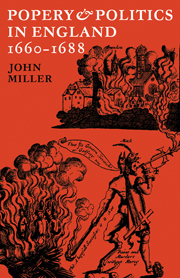Book contents
- Frontmatter
- Contents
- Preface
- Abbreviations
- Note on spellings and dates
- Introduction
- 1 The Catholic laity
- 2 England and Rome: the Catholic clergy
- 3 The penal laws and their enforcement
- 4 The development of the anti-Catholic tradition
- 5 The Restoration settlement and after
- 6 The French alliance and ‘Catholicity’
- 7 York and Danby
- 8 The Popish Plot and the Exclusion Crisis
- 9 The Tory reaction
- 10 James II and the Church of England Men
- 11 James II and the Dissenters
- 12 James II and Rome
- 13 The missionary effort under James II
- 14 The opposition to James II
- Appendices
- Select Bibliography
- Index
2 - England and Rome: the Catholic clergy
Published online by Cambridge University Press: 07 October 2011
- Frontmatter
- Contents
- Preface
- Abbreviations
- Note on spellings and dates
- Introduction
- 1 The Catholic laity
- 2 England and Rome: the Catholic clergy
- 3 The penal laws and their enforcement
- 4 The development of the anti-Catholic tradition
- 5 The Restoration settlement and after
- 6 The French alliance and ‘Catholicity’
- 7 York and Danby
- 8 The Popish Plot and the Exclusion Crisis
- 9 The Tory reaction
- 10 James II and the Church of England Men
- 11 James II and the Dissenters
- 12 James II and Rome
- 13 The missionary effort under James II
- 14 The opposition to James II
- Appendices
- Select Bibliography
- Index
Summary
In this chapter I shall consider two further aspects of the situation of the English Catholics; each is concerned with the relationship of the surviving Catholic minority to the pope and the court of Rome. First, the breach with Rome left Catholics with the problem of reconciling two traditional and ingrained loyalties, to the king and to the pope, which were no longer strictly compatible. Although Catholics tried to reconcile the two by obeying the king in temporal matters and the pope in spiritual matters, their position was made more difficult by the wording of the oath of allegiance which the English state imposed on them in 1606. Secondly, starting in Elizabeth's reign, the English clergy and the papacy had started to build a new ecclesiastical organisation to help meet the spiritual needs of a persecuted minority. The strains and squabbling inevitable in such a situation were made more serious by the attempt of a section of the secular clergy to set up an organisation, based on a bishop and chapter, which would be independent of Rome for most practical purposes. Disputes about the legality of the Chapter complicated and exacerbated the disputes over the oath of allegiance which rent the clergy, and with them the laity, through most of the seventeenth century. Usually the secular priests (those belonging to no order, the equivalent of parish priests in Catholic countries), advocated greater submission to the English state and greater independence of Rome, while the regulars were more sensible of their duty to uphold the rights of the church and of the pope.
- Type
- Chapter
- Information
- Popery and Politics in England 1660–1688 , pp. 28 - 50Publisher: Cambridge University PressPrint publication year: 1973
- 1
- Cited by



